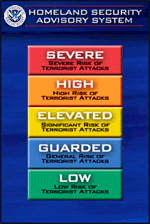WASHINGTON – In her recent “State of America’s Homeland Security” address, Secretary of Homeland Security Janet Napolitano erased the color-coded system that warned citizens of domestic terror attacks, eliminating a system that had become a staple for late-night comedians’ jokes and much public ridicule.

The Homeland Security Advisory System used an array of colors to warn Americans. (Source: Dept. of Homeland Security)
The spectrum, formally known as the Homeland Security Advisory System, was created in 2002 with its five tiers (ranging from low green to severe red) that gauged air travel security in the post-9/11 world. Napolitano said it will be replaced by the National Terror Advisory System, a colorless scale. But the color-coded system will remain for 90 days (as of early February, the threat shade was yellow, or “elevated”) while the new system goes through a waiting period to allow the public and experts to consider its implications.
According to an official DHS statement, the new system will issue fewer warnings than its predecessor by “providing timely, detailed information to the public, government agencies, first responders, airports and other transportation hubs, and the private sector.” In other words, the alerts would clearly state the pending “imminent” or “elevated threat.”
“When a threat develops that could impact you – the public – we will tell you . . . whatever information we can so you know how to protect yourselves, your families and your communities,” said Napolitano during her speech at the George Washington University Homeland Security Policy Institute.
She added that alerts would be widely broadcast to the American public through both official outlets (such as the DHS website) and social media sites (including Facebook and Twitter @NTASAlerts). But depending on the situation’s severity, only some alerts would be sent to the public; in unverified threats, DHS would directly notify law enforcement agencies.
James Carafano, a homeland security expert at the conservative Heritage Foundation, said the new system will be kind to the DHS budget. When alerts skyrocketed to say, orange, airports and government agencies responded by ratcheting up security (i.e. canceling flights, beefing up border control), which cost money. However, with fewer warnings come fewer reactions.
“[NTAS] won’t save money, but it will keep you from spending money,” Carafano said.
He also warned that DHS should be cautious in its use of social media.
“Social media is a valuable tool,” Carafano said. “But it’s subject to manipulation by manipulative actors.”
Last November, a hacker sent a fake tsunami warning from an Indonesian government official’s Twitter account, causing widespread panic.
Many politicians and experts agree that the HSAS colors have become obsolete. In 2009, Napolitano met with a DHS taskforce to assess whether HSAS was truly useful; that’s when officials agreed to sack the system. According to a CNN article, the top Republicans and Democrats on the House Homeland Security Commission reacted positively to Napolitano’s decision to cancel the color-coded system, although committee chairman Rep. Peter King, R-N.Y., said only time will tell if NTAS truly works.
Michael O’Hanlon, a national security analyst at the Brookings Institution, said the U.S. will benefit from ending the outdated system. “HSAS wasn’t really accomplishing anything anyway,” O’Hanlon said. “It wasn’t designed for insiders, operators or intelligence people, and the public didn’t really know what to do with the warnings.”
But Napolitano conceded in her speech that U.S. borders are safer now compared with 10 years ago because of the color-coded alerts, but she also explained that the country needs a new system that includes all members in its notification process. It remains to be seen how more people will be involved if DHS notifies fewer people in some cases.





